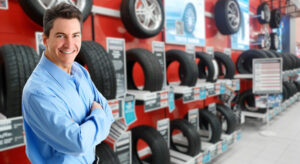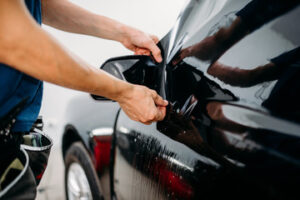San Clemente Tire Shop helps people keep their cars safe and reliable. They also provide a wide range of other services, including wheel alignments and balancing.

Choosing the right name for your Tire Shop can have a significant impact on customers’ impressions of your business. It should be unique and convey a sense of individuality and professionalism.
When you’re shopping for new tires, you can often get better prices from a local tire store than from your car dealer. The only drawback is that they may not have the specific tires you want in stock. However, the tires that you choose will be of better quality and are likely to last longer than the original tires on your vehicle.
In addition, many tire stores offer discounts on mounting, balancing and rotation services when you purchase a set of tires. It’s also possible to find coupons and rebates for tires at the tire shop. Regardless of where you buy your tires, always remember that the most important thing is to make sure that they are the right size for your vehicle. You can use a tool online that takes your vehicle’s year and model into account to find the perfect fit.
Once you have found the best tires for your vehicle, it’s important to keep them properly maintained in order to maintain their performance and extend their life. You can do this by rotating them regularly and balancing them on an ongoing basis. It’s also a good idea to wash them periodically.
You should also keep in mind that your tires can affect the way your vehicle uses fuel. As the tread on your tires wears down, it increases rolling resistance, which means that more energy is needed to propel the car forward. New tires, with their optimal tread depth and advanced materials, reduce rolling resistance, which leads to improved gas mileage.
The type of tires that you choose should depend on your driving habits and the road conditions in your area. Some types of tires are better suited to specific conditions, such as snow or off-roading. It’s also a good idea for drivers to have at least one spare tire, in case of a puncture or other emergency.
A well-maintained and balanced set of tires can help to improve your vehicle’s handling, responsiveness, and braking capabilities. Whether you are navigating city streets or challenging terrain, the optimal performance of your tires will make your driving experience safer and more enjoyable.
Buying Used Tires
Purchasing used tires is a smart financial choice for many drivers. Whether you’re a car enthusiast who loves to tinker under the hood, a frugal consumer seeking budget-friendly options, or a first-time car owner stepping into the world of vehicle maintenance, you know that your motor makes your wheels move but without an efficient set of tires, you won’t get far.
When shopping for a new set of tires, look for ones that are certified and come with a warranty. Typically, certified tires are thoroughly tested and adhere to specific safety standards, while warranties give you peace of mind in case the tires develop issues or prematurely wear down.
If you’re in the market for a new set of tires, make sure to shop around and find the best deal. Many tire shops offer seasonal promotions, loyalty discounts, and other incentives to draw in customers. You may also be able to save money on tire services, such as wheel alignments or tire storage.
Local Tire Shops
Tire shops that focus solely on tires are often a treasure trove for unused sets of tires, especially if they have good tread left. They can refurbish and sell them to car enthusiasts or ordinary drivers looking for a great deal.
Online Marketplaces
Purchasing and selling used tires is easier than ever thanks to online marketplaces like Facebook Marketplace and Craigslist. These sites allow buyers to browse local listings and connect with sellers who can inspect the tires in person before making a purchase.
As a tire shop, you can increase your reach by advertising on these platforms and hosting workshops where locals can learn about how to take care of their tires. This establishes your tire shop as an expert and a trusted resource for the community. It’s also a great way to build customer trust and brand awareness. You can even invite customers to post their own tire care tips on social media to further promote your business.
Tire Rotation
Tire rotation is a key service that can help you extend the life of your tires and improve the overall performance of your vehicle. It involves moving your car’s tires to different positions on the vehicle’s axles, which allows for more even wear. Regular tire rotation can help reduce your risk of tire damage and early deterioration, helping to save you money in the long run.
Tires are one of the most important components of your car, and they play a significant role in the safety, handling, and fuel efficiency of your vehicle. They are also the sole point of contact with the road, and they must be properly maintained to ensure maximum performance and durability. Some of the most crucial maintenance tasks for tires include tire rotation, wheel alignment, and balancing.
Your tires can be rotated every 5,000 to 7,500 miles, but this number may vary depending on the manufacturer of your vehicle. It’s always a good idea to check your owner’s manual for a precise figure. A tire rotation typically involves moving the front tires to the back and then swapping the rear tires with the front ones. However, there are several other variations that can be used.
Generally speaking, your front tires will wear down more quickly than the rear tires, as they are responsible for most steering and braking activities. This is why front-wheel drive vehicles require more frequent tire rotations than rear-wheel drive models. The type of drivetrain on your vehicle will also affect the wear pattern of your tires.
It’s also important to note that your tire rotation should be performed in conjunction with wheel alignment and balancing services, as improperly inflated or unbalanced tires will result in uneven wear. You can find these services at most auto shops, but it’s generally best to visit a tire shop with an experienced team that is familiar with all aspects of the automotive industry.
Getting your tires rotated on a regular basis can help you extend their lifespan and maximize performance, making it an essential part of any car maintenance regimen. It’s a relatively inexpensive service that offers a multitude of benefits, including better traction, improved fuel efficiency, and longer tire tread life.
Tire Repair
If a tire suffers a puncture, it’s important to take the vehicle to a professional for inspection. An automotive service professional has the expertise to determine whether a tire is repairable, and they can also perform a detailed inspection to look for other mechanical issues that may be causing vibrations or handling problems when driving.
The location of the puncture will be the biggest factor in determining whether it can be repaired or not. If the puncture occurred in the tread area, it can usually be fixed using a plug or patch. The sidewall of the tire is off limits for repairs because it undergoes significant stress during use and any attempt to make a patch in this area will probably fail.
Performing the repair properly is also essential. A tire service technician will follow the directions in their repair kit to ensure the plug or patch is installed correctly and that it holds air pressure. They’ll also inspect the tire for leaks after the repair by applying soapy water to the surface of the patch and looking for bubbles.
In addition to puncture repairs, a tire service shop can provide other types of tire repair and maintenance. This includes tire balancing, which evens out the wear of tires and improves ride quality. Tire rotation is another helpful service that can extend the life of tires by preventing uneven wear, which can lead to blowouts and unsafe driving conditions.
A well-equipped tire service shop should have reception and waiting areas, service bays, and storage space for inventory. It should be well-organized to maximize workflow and efficiency. It’s also a good idea to invest in point-of-sale software for the business that will help automate tasks and improve customer service. The software will allow technicians to track inventory, create tire swap repair orders and flag tires for replacement, as well as search for tires by size, VIN or warehouse number. It will also allow technicians to place orders with industry recognized tire distributors. This way, customers can get their tires quickly and efficiently. This will save the tire shop money on shipping costs and reduce order processing time.

